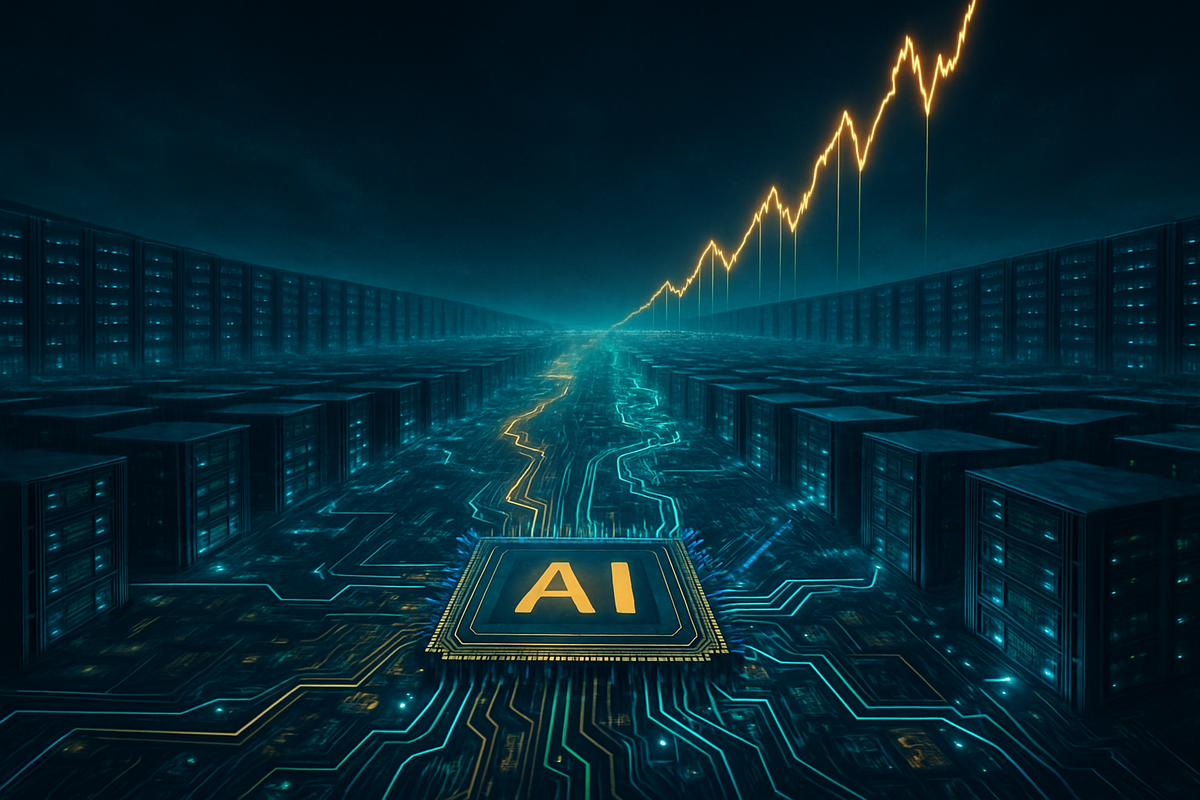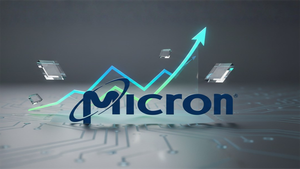
The global financial markets are currently witnessing an unprecedented surge in Artificial Intelligence (AI) infrastructure spending, a phenomenon that is profoundly reshaping the technology sector and creating both immense opportunities and significant risks for public companies. As of October 2025, major tech giants, often dubbed "hyperscalers," are pouring hundreds of billions into building the foundational hardware and cloud capabilities necessary to power the next generation of AI, driving U.S. stock market gains and economic growth. This aggressive investment spree is not merely a fleeting trend but a fundamental re-architecture of digital infrastructure, with far-reaching implications for investors, businesses, and society at large.
The immediate implications are clear: companies providing the "picks and shovels" for AI—semiconductor manufacturers, cloud computing services, and specialized data center providers—are experiencing boom times. However, this capital-intensive race also raises questions about sustainability, market concentration, and the potential for a new kind of "AI bubble" if returns don't materialize as quickly as investments.
Unprecedented Investment Fuels the AI Engine
The scale of investment in AI infrastructure is staggering. Global AI infrastructure spending is experiencing an unprecedented boom, with projections for overall global AI investment to reach $2 trillion by 2026. In the first quarter of 2025, global cloud infrastructure spending hit $90.9 billion, a 21% increase year-over-year, continuing into Q2 2025 with $95.3 billion, a 22% rise. Analysts now project global AI infrastructure spending to reach $375 billion in 2025 and $500 billion by 2026.
Leading this charge are the tech titans: Amazon (NASDAQ: AMZN), Microsoft (NASDAQ: MSFT), Alphabet (NASDAQ: GOOGL), and Meta Platforms (NASDAQ: META) are expected to collectively spend over $300 billion on capital expenditures in 2025, with the vast majority earmarked for AI. Specific projections for 2025 include Amazon at $100 billion, Microsoft at $80 billion, Alphabet at $75 billion, and Meta at $60-65 billion. Citigroup analysts further anticipate hyperscalers to spend $490 billion on infrastructure and capital goods in 2026, an increase from earlier estimates.
This surge is underscored by mega-deals and strategic partnerships. OpenAI, for instance, has inked a five-year contract worth $300 billion with Oracle (NYSE: ORCL) for computing power, part of the ambitious $500 billion "Stargate Initiative" with Nvidia (NASDAQ: NVDA). Another significant agreement involves Nebius Group providing Microsoft with $17.4 billion in GPU capacity over five years. Cloud infrastructure provider CoreWeave has secured substantial contracts, including a total contract value of $22.4 billion with OpenAI and a $14.2 billion AI cloud infrastructure deal with Meta. These deals highlight a critical shift: the financing of this massive buildout is increasingly relying on debt rather than solely cash flows, introducing new financial risks like default and interest rate exposure.
Recent market developments in September 2025 further emphasize this relentless acceleration. Beyond individual company commitments, a consortium of U.S. tech firms, including Microsoft and Nvidia, announced a multi-billion-dollar AI infrastructure investment plan for the UK. Google increased its 2025 capital expenditure target from $75 billion to $85 billion, AWS projects over $100 billion in spending, and Microsoft plans around $80 billion for infrastructure expansion in its current fiscal year. New modular AI factory solutions are promising to reduce deployment times for AI data centers to under six months, while semiconductor manufacturers like Kioxia and SanDisk have launched new fabrication facilities to meet escalating demand.
Winners and Losers in the AI Arms Race
The AI infrastructure spending boom is creating a clear hierarchy of beneficiaries, while simultaneously posing significant challenges for companies unable to adapt or those whose business models are disrupted.
The Clear Winners:
- Chip Manufacturers: At the forefront are companies like Nvidia (NASDAQ: NVDA), the undisputed leader in AI hardware. Its data center segment revenue surged an astounding 142% year-over-year in fiscal year 2025, briefly pushing its market capitalization past $4 trillion. Nvidia's stock is up 33% in 2025, with analysts expecting continued strong performance. Advanced Micro Devices (NASDAQ: AMD) is emerging as a strong challenger with its EPYC processors and Instinct GPUs, reporting record Q2 2025 revenues of $7.7 billion, up 32% year-over-year, and its shares gaining 33.1% year-to-date. Broadcom (NASDAQ: AVGO) is also benefiting significantly from its AI chips and networking products, with AI revenue surging 63% year-over-year and its stock up 48% year-to-date. Taiwan Semiconductor Manufacturing (NYSE: TSM), as the primary manufacturer of advanced AI chips, directly benefits from increased demand.
- Cloud Service Providers (Hyperscalers): Microsoft (NASDAQ: MSFT), with its Azure cloud platform, continues robust growth, significantly fueled by AI demand. Its Microsoft Cloud revenue was approximately $46.7 billion in Q4 FY2025, a 27% increase. Amazon (NASDAQ: AMZN), through AWS, is making substantial AI infrastructure investments, though its stock performance has been more modest, up about 3% in 2025, partly due to heavy capital outlays impacting AWS operating margins. Alphabet (NASDAQ: GOOGL) is turning AI into a core growth driver, committing $75 billion in capital expenditures for 2025 to expand Google Cloud and AI services. Oracle (NYSE: ORCL) is a key player in significant AI infrastructure projects, anticipating soaring cloud infrastructure revenue growth.
- Server and Data Center Equipment Providers: Dell Technologies (NYSE: DELL) is a leading supplier of AI-optimized servers, raising its annual AI server shipment forecast to $20 billion. Its Infrastructure Solutions Group (ISG) saw record revenues, increasing 44% year-over-year in Q2 fiscal 2026.
- Specialized AI Cloud Providers: Companies like CoreWeave, specializing in AI workloads, saw revenue grow 150% year-over-year in Q2 FY2025, highlighting their critical role in supporting AI development.
Companies Facing Challenges or Potential Losses:
- Companies with Lagging AI Adoption/Integration: Many businesses struggle with integrating new AI technologies into existing legacy systems, incurring costly integration issues and operational hiccups. Those with poor data quality or without a clear return on investment for AI projects may face financial strain.
- Industries Susceptible to AI Disruption: AI-driven automation is leading to job displacement across various sectors. Manufacturing, retail, transportation, customer service, banking, legal services, and journalism are seeing significant portions of tasks automated, potentially impacting the demand for services from companies reliant on human-centric processes in these fields.
- Smaller or Overleveraged Data Center Builders: Analysts forecast that many smaller or overleveraged data center builders may not survive the next few years if monetization does not catch up to the infrastructure costs.
- Companies with High R&D Costs and Margin Pressures: While investing heavily, some tech giants like Amazon are seeing pressure on AWS operating margins due and Dell Technologies faces margin squeezes for AI servers, raising investor anxieties about whether these massive expenditures will consistently translate into profitability.
Wider Significance: A New Digital Frontier
The AI infrastructure spending surge is not just about quarterly earnings; it represents a profound shift with wider significance across the industry, regulatory landscape, and historical context.
Broader Industry Trends: This boom is a primary driver of U.S. stock market gains and economic growth. However, the increasing reliance on debt to finance these massive capital expenditures introduces new vulnerabilities related to default and interest rate risk. A critical and growing concern is the immense energy consumption of AI data centers. By 2035, U.S. data center power demand is projected to more than double, with AI driving much of this increase. Global electricity demand from data centers could reach 1,200 terawatt-hours by 2035, potentially increasing global carbon emissions by 220 million tons if not met by renewable sources. This necessitates a comprehensive strategy for decarbonizing digital infrastructure.
Ripple Effects on Competitors and Partners: The spending spree has intensified competition and fostered extensive collaborations. Hyperscalers' investments directly benefit AI infrastructure providers like Nvidia, which is estimated to have 60% to 80% exposure to every $100 spent on AI implementation. The rise of specialized AI cloud providers like CoreWeave validates their business model but also compels traditional cloud computing giants to accelerate their specialized AI offerings or consider acquiring smaller players. A significant trend is the push towards vertical integration, with major tech companies developing their own custom AI chips (XPUs) to reduce reliance on dominant GPU suppliers and optimize performance, signaling a fundamental restructuring of computational power distribution.
Regulatory or Policy Implications: The rapid growth in AI infrastructure spending is leading to increasing demands for regulatory oversight. Compliance, security, and data sovereignty are becoming foundational, with regulations like GDPR and the EU AI Act raising accountability standards. Governments are grappling with potential societal impacts, including significant job displacement (estimated at 40% of existing jobs) and exacerbated inequalities. In the U.S., the White House Office of Science and Technology Policy (OSTP) issued a Request for Information in September 2025, seeking comments on federal statutes that might hinder AI development, reflecting an ongoing debate about the nature and extent of necessary regulation.
Historical Precedents: The current AI infrastructure boom is often compared to past technology-led capital cycles, such as the railroad and internet (dot-com) booms. During the dot-com era, massive overbuilding of fiber optic cables led to a subsequent bust. While some analysts warn of an "AI bubble" due to intense spending and debt reliance, others argue that the current boom is different, underpinned by tangible demand and efficiency gains from highly profitable tech giants. However, the rapid pace of AI innovation introduces new uncertainties, such as equipment obsolescence and potential writedowns, reminiscent of past infrastructure cycles.
What Comes Next: Navigating the AI Frontier
The future of AI infrastructure spending is poised for continued aggressive expansion, but also for strategic pivots and the emergence of both new opportunities and significant challenges.
Short-Term (Late 2025 - 2027) Possibilities: The immediate future will see aggressive expansion by hyperscalers, with global AI spending projected to reach nearly $1.5 trillion in 2025. Hardware, particularly specialized processors like GPUs, will continue to dominate the AI infrastructure market, with an over 80% share in data center AI workload deployments. Expect a significant shift towards more specialized, high-performance computing solutions and liquid cooling systems for thermal loads exceeding 40kW per rack. Cloud-based generative AI (GenAI) spending is expected to quadruple, with 90% of companies anticipating GenAI to constitute at least 10% of their cloud budget within three years.
Long-Term (2028 - 2035 and beyond) Possibilities: The long-term outlook projects global AI infrastructure spending potentially reaching $4 trillion by 2030, according to Nvidia's forecast. McKinsey estimates a need for $5.2 trillion into data centers by 2030 to meet AI demand. A significant long-term shift is anticipated in AI workload allocation: while 70% of AI-related data center capacity is currently for training models, this is expected to reverse by 2029, with 70% dedicated to AI inferencing. This suggests a maturation of the AI market from foundational model development to widespread application.
Potential Strategic Pivots: Companies like Nvidia are transitioning from merely selling GPUs to becoming "AI infrastructure contractors," building entire ecosystems. The rise of specialized cloud providers (neoclouds) like CoreWeave represents a significant pivot, creating pressure on traditional cloud giants. Major cloud providers are increasingly developing their own custom AI chips (ASICs) for competitive advantage. There's also a growing reliance on debt financing for these massive buildouts, a strategic shift that introduces new financial vulnerabilities. Furthermore, with escalating power demands, companies are making strategic pivots towards optimizing energy consumption and workload management, including investments in more effective cooling solutions.
Market Opportunities: The surge presents numerous opportunities in AI hardware (chips and accelerators), data center construction and real estate, cloud AI computing services, AI infrastructure software, and power/energy infrastructure. The soaring electricity demand from AI data centers creates significant opportunities for power providers and new energy generation, with the US alone needing an additional 100 gigawatts of power capacity by 2030 for AI needs. Edge AI computing and sustainable AI solutions also present growing markets.
Market Challenges: Significant challenges include the immense capital intensity required, compute scaling limits, and persistent supply chain constraints for key components. Energy and power constraints are critical, with data centers becoming giant energy users, and securing land, power, and permits posing significant hurdles. Cost management and ROI uncertainty are also major concerns, as many AI projects (up to 95%) currently fail to generate returns. Talent shortages, geopolitical tensions affecting supply chains, and the massive environmental impact of AI data centers are also pressing issues.
Potential Scenarios: The future could see continued hyperscale dominance with specialized niches, or an accelerated growth leading to infrastructure overbuild if demand doesn't keep pace. A sustainability-driven reshaping is also possible, forcing pivots towards energy-efficient designs. Further consolidation and vertical integration, or an innovation-led efficiency gain that mitigates demand pressures, are other plausible outcomes. Finally, geopolitical tensions could lead to a fragmented AI infrastructure with more localized development.
The Enduring Impact of the AI Infrastructure Boom
The AI infrastructure spending surge is undoubtedly one of the most transformative financial events of our time, analogous to past industrial revolutions. It underscores a fundamental shift in how technology is built, deployed, and consumed, creating a new digital frontier. The key takeaways are clear: unparalleled investment is driving rapid innovation, but also concentrating power, straining resources, and necessitating new regulatory frameworks.
Moving forward, the market will be characterized by intense competition among hyperscalers and chip manufacturers, a continued focus on vertical integration, and a growing emphasis on energy efficiency and sustainability. Investors should watch for companies that can not only innovate in AI hardware and software but also effectively manage the immense capital expenditures and address the environmental footprint of their operations. The ability to secure reliable power, navigate complex supply chains, and attract top AI talent will be crucial differentiators.
The lasting impact of this boom will be a more intelligent, interconnected, and automated world. However, the journey there will be fraught with financial risks, ethical dilemmas, and environmental challenges that demand careful stewardship from all stakeholders. The coming months will reveal whether the current "fragile boom" can mature into sustained, profitable growth, or if the echoes of past technological overbuilds will eventually resonate.
This content is intended for informational purposes only and is not financial advice.






